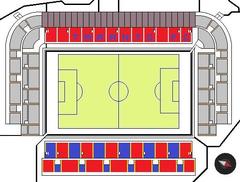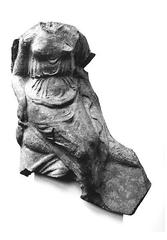National Archaeological Museum of Taranto: Visiting Hours, Tickets, and Travel Guide
Date: 15/06/2025
Introduction
The National Archaeological Museum of Taranto (MArTA) stands as a cultural beacon in southern Italy, offering an immersive journey through the history of Magna Graecia and beyond. Since its founding in 1887, MArTA has been dedicated to preserving and showcasing artifacts that narrate the evolution of Taranto and the wider Mediterranean region. Housed in a historic neoclassical building in the heart of Taranto, the museum’s diverse collections—from prehistoric tools to Hellenistic gold jewelry—make it an essential destination for history enthusiasts and travelers alike.
This comprehensive guide provides up-to-date information on visiting hours, tickets, accessibility, and insider tips, alongside an overview of the museum’s highlights and nearby attractions. Whether you’re a passionate archaeologist, a student, or a casual visitor, MArTA offers an enriching experience that connects the past to the present.
For official updates and in-depth resources, visit the MArTA official website, and explore further references at the end of this article.
Table of Contents
- History and Evolution of the Museum
- Highlights of the Collection
- Significance of Taranto in Magna Graecia
- Visitor Information: Hours, Tickets, and Accessibility
- Museum Layout and Navigating Your Visit
- Guided Tours and Educational Programs
- Facilities, Amenities, and Visitor Etiquette
- Nearby Attractions and Travel Tips
- Frequently Asked Questions (FAQ)
- Conclusion and Further Resources
History and Evolution of the Museum
Established in 1887 and opened to the public in 1905, the National Archaeological Museum of Taranto was created to safeguard the region’s archaeological treasures. The museum resides in the former Convent of the Friars Alcantarini, purchased by the Municipality of Taranto in 1875 (Museo Taranto). MArTA played a pioneering role in archaeological preservation in Italy, introducing regulated excavation practices and legal frameworks for artifact discovery.
The building underwent significant expansions in the 20th century, with new exhibition wings and a neoclassical façade by Guglielmo Calderini. A major reorganization from 2000–2007 modernized the exhibition spaces, and the second floor was inaugurated in 2016, further enriching the visitor experience.
Highlights of the Collection
MArTA is internationally acclaimed for its “Ori di Taranto” (Gold of Taranto) collection—a dazzling array of Hellenistic jewelry that testifies to the artistry and sophistication of Taranto’s ancient goldsmiths (Wikipedia). The museum’s treasures extend beyond gold, featuring:
- Greek polychrome pottery and Attic vases
- Terracotta figurines and funerary urns
- Roman mosaics, coins, and marble sculptures
- Prehistoric stone tools, pottery, and burial items
- Medieval and Byzantine jewelry and religious artifacts
These pieces illuminate the daily life, beliefs, and artistic achievements of the region’s inhabitants across millennia (ImaginApulia).
Significance of Taranto in Magna Graecia
Taranto, known as “Taras” in antiquity, was founded by Spartan colonists in the 8th century BCE and became a dominant city of Magna Graecia. Its strategic location facilitated cultural exchange and economic prosperity through Greek, Roman, and later periods. MArTA’s exhibits trace this trajectory, offering visitors a chronological exploration from the Paleolithic era to the Middle Ages (ImaginApulia; Savoring Italy).
Visitor Information: Hours, Tickets, and Accessibility
Opening Hours
- Tuesday to Sunday: 9:00 AM – 7:00 PM (last admission at 6:00 PM)
- Closed: Mondays, January 1, and December 25
Check the official website for updates, especially on holidays or special events.
Ticket Prices
- General Admission: €8–€10 (check official site for updates)
- Reduced Admission: €4–€5 (EU citizens 18–25, seniors 65+, groups)
- Free Entry: Under 18s, Taranto residents, disabled visitors and companions, and on the first Sunday of each month
Tickets can be purchased at the museum or online via the official ticketing portal.
Accessibility
- Wheelchair accessible with ramps and elevators
- Accessible restrooms and tactile exhibits
- Assistance animals permitted
- Multilingual signage and Braille guides available
For specific needs, contact the museum in advance at [email protected] or +39 099 4717577.
Museum Layout and Navigating Your Visit
Building and Layout
The museum spans three levels in a centrally located neoclassical building (Museo Taranto):
- Ground Floor: Reception, ticketing, cloakroom, and introductory displays
- First Floor: Permanent exhibits—Greek, Roman, and Magna Graecia artifacts, including the Gold of Taranto
- Second Floor: Prehistoric collections, temporary exhibitions, and educational spaces
- Mezzanine: Bishop Ricciardi’s private collection of paintings and religious art
Clear bilingual signage and logical chronological arrangement guide visitors through the evolving story of Taranto.
Suggested Routes
- Standard chronological route: Start from Prehistory on the second floor, proceeding to Greek and Roman exhibits on the first floor.
- Thematic self-guided tours (available via brochures or the MArTA app) focus on specific topics such as daily life or funerary practices.
Allow 2–3 hours for a comprehensive visit.
Guided Tours and Educational Programs
- Official Guided Tours: Available in Italian and English, led by archaeologists. Book in advance via the museum’s website.
- Audio Guides: Multilingual, available for rent.
- Group Visits: Discounts for groups of 10+; advance reservation required.
- Family and School Programs: Includes children’s workshops, treasure hunts, and hands-on educational activities (MArTA official).
MArTA also hosts temporary exhibitions and interactive installations to enhance learning for all ages (Google Arts & Culture).
Facilities, Amenities, and Visitor Etiquette
Onsite Facilities
- Cloakroom: Free lockers for bags and umbrellas
- Restrooms: On every floor, with accessible options
- Wi-Fi: Complimentary
- Museum Shop: Books, replicas, and local artisan crafts
- Café: Light refreshments and pastries
Food and drink are not permitted in exhibition areas.
Visitor Etiquette and Photography
- Speak softly and supervise children
- Do not touch artifacts or display cases
- Photography for personal use is permitted without flash or tripods; filming requires prior permission
Nearby Attractions and Travel Tips
How to Get There
- Address: Via Cavour, 10, 74123 Taranto, Italy
- By Train: 15-minute walk from Taranto’s main railway station
- By Bus: Lines 2, 3, and 4 stop nearby (AMAT Taranto)
- By Car: Paid parking in the vicinity (limited spaces)
Nearby Sites to Explore
- Aragonese Castle: Guided tours of this medieval fortress
- Old Town (Città Vecchia): Stroll historic streets and waterfront
- Doric Temple Columns: Ancient Greek ruins
- Swing Bridge (Ponte Girevole): Iconic rotating bridge
Consider the “Taranto Card” for combined entry to multiple attractions.
Frequently Asked Questions (FAQ)
Q: What are the museum’s opening hours?
A: Tuesday to Sunday, 9:00 AM–7:00 PM; closed Mondays. Last entry at 6:00 PM.
Q: How much are tickets?
A: General admission €8–€10; reduced €4–€5; free for under 18s and on the first Sunday of each month.
Q: Are guided tours available in English?
A: Yes, book in advance on the museum website.
Q: Is the museum wheelchair accessible?
A: Fully accessible with ramps, elevators, and accessible restrooms.
Q: Can I take photos inside?
A: Yes, for personal use without flash or tripods.
Conclusion and Further Resources
The National Archaeological Museum of Taranto is a premier destination for anyone interested in Italy’s ancient past. Its extraordinary collections, innovative educational programs, and central location near Taranto’s top attractions provide a memorable and enriching experience for all visitors.
For the latest news, exhibitions, and ticketing information, visit the official MArTA website. Enhance your visit with the Audiala app for interactive guides and exclusive content.
Share your experience on social media using #MArTA and continue exploring Taranto’s rich history through related guides and virtual resources.

